
 |
|
|
|
|
|
Pyrite Ooids from the Winnipeg Formation (Ordovician) |
|||
| A somewhat different story than told by the Devonian pyrite ooids. We studied pyrite ooids from the Winnipeg Formation, are largely sand-dominated succession in the Ordovician of the Williston Basin. These pyrite ooids are a bit more irregular, but again are primarily found associated with stratigraphic intervals that mark stagnant sedimentation and erosive interludes. | |||
| Location map of known Ordovician pyrite ooid occurrences. We used samples from drill cores through the Winnipeg Formation of Saskatchewan. |
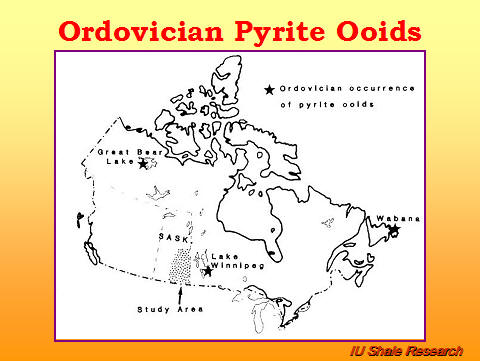 |
||
| Location of sampled drill cores and map of sandstone/shale distribution in the Black Island member of the Winnipeg Formation. |
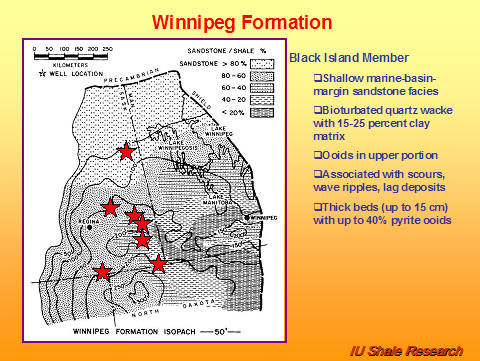 |
||
| A typical stratigraphic section of the Winnipeg Formation with an occurrence of abundant pyrite ooids marked. there are other, less prominent, occurrences lower down in the Black Island member. |
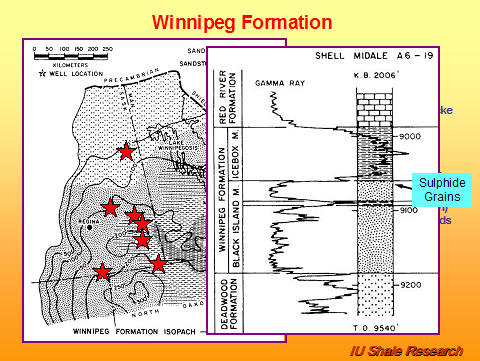 |
||
| Typical sandstone with pyrite ooids. The large pyrite grains are approximately 1-1.5 mm in diameter. |
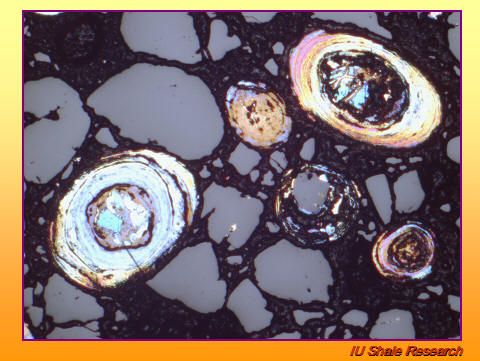 |
||
| There are different ooid
morphologies: (A) large marcasite cores with thin cortexes; (B)
marcasite cores with pyrite-marcasite cortexes; (C) thick laminated
with quartz inclusions; and (D) thick irregular laminae. The marcasite cores are the reworked and rounded remains of marcasite mineralized burrows within Winnipeg sandstones (reference below). |
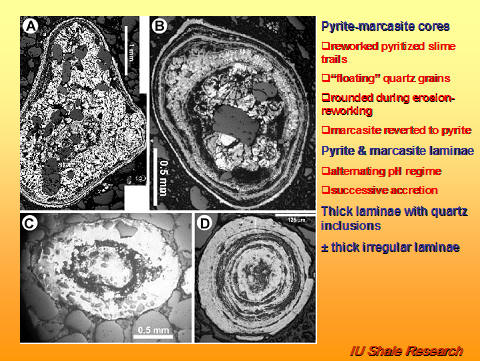 |
||
|
Reference for above (marcasite cores): Schieber, J. 2002, The Role of an Organic Slime Matrix in the Formation of Pyritized Burrow Trails and Pyrite Concretions. Palaios, v. 17, p. 104-109. download PDF file (left click on link and click on "Save as"...) |
|||
| In contrast to the Devonian pyrite ooids, the Winnipeg cortexes are free of microscopic silicate inclusions and show variable S-isotope ratios from cortex to cortex. Both features are consistent with primary pyrite accretion (one cortex at a time) during formation of these ooids. |
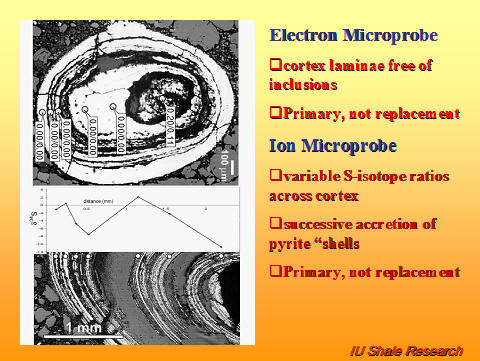 |
||
| see slide text. |
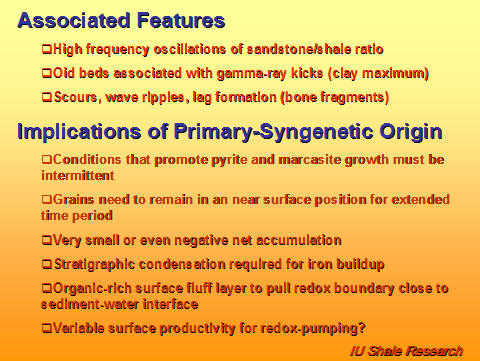 |
||
| A model for formation of the
different pyrite ooid morphologies as a result of a combination of
erosion-exhumation and/or shallow burial with up-down oscillation of
sulfate reduction zone (SRZ). The initial cores are provided by reworking of pyrite-marcasite mineralized burrows. |
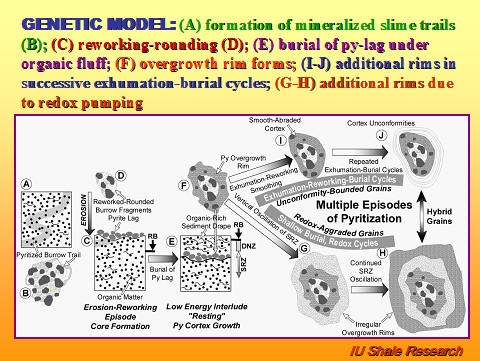 |
||
| Marcasite cortices form when
surficial iron sulfide oxidation temporarily lowers pH and raises Fe
in pore waters (hydrogen sulfide provided by underlying sediment). A hypothesis, but there is petrographic evidence of intermittent iron sulfide oxidation (see below). |
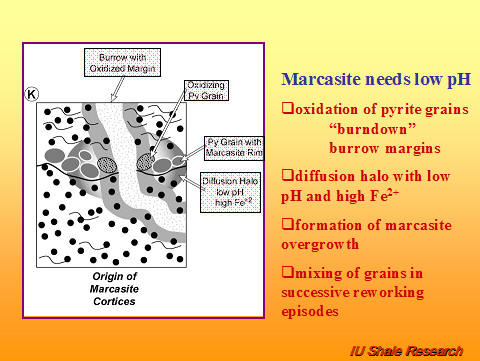 |
||
| Alternating cortices of pyrite, marcasite, and pyrite-marcasite mixtures. Minerals identified by electron backscatter diffraction under the SEM. |
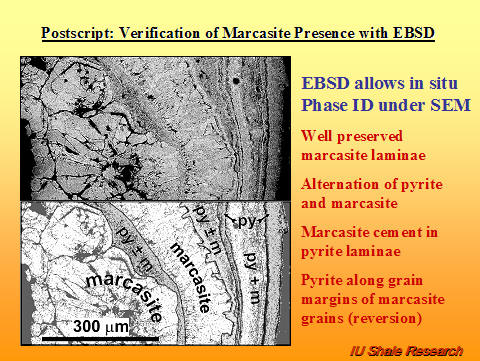 |
||
| When cortex boundaries from above are examined in detail, we see corrosive surfaces separating successive cortices. This supports above scenario of intermittent sulfide oxidation, lowering of pH, and marcasite precipitation. |
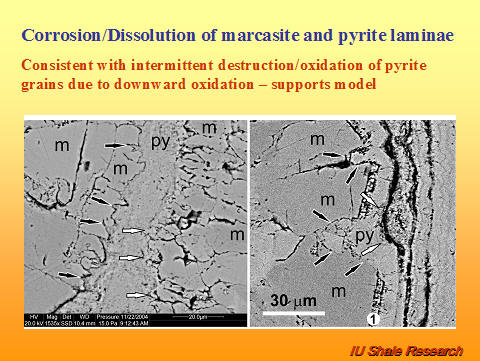 |
||
| The context of Winnipeg pyrite ooids, and what they can tell us about depositional history. More details in the JSR paper on these grains (below). |
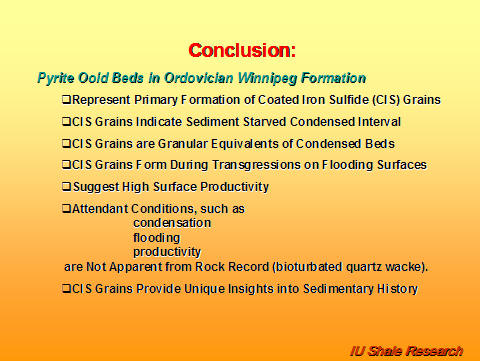 |
||
|
Reference for above: Schieber, J., and Riciputi, L. 2005, Pyrite-marcasite coated grains in the Ordovician Winnipeg Formation, Canada: An intertwined record of surface conditions, stratigraphic condensation, geochemical “reworking”, and microbial activity. Journal of Sedimentary Research, v. 75, p. 905-918. Link |
|||
|
|||